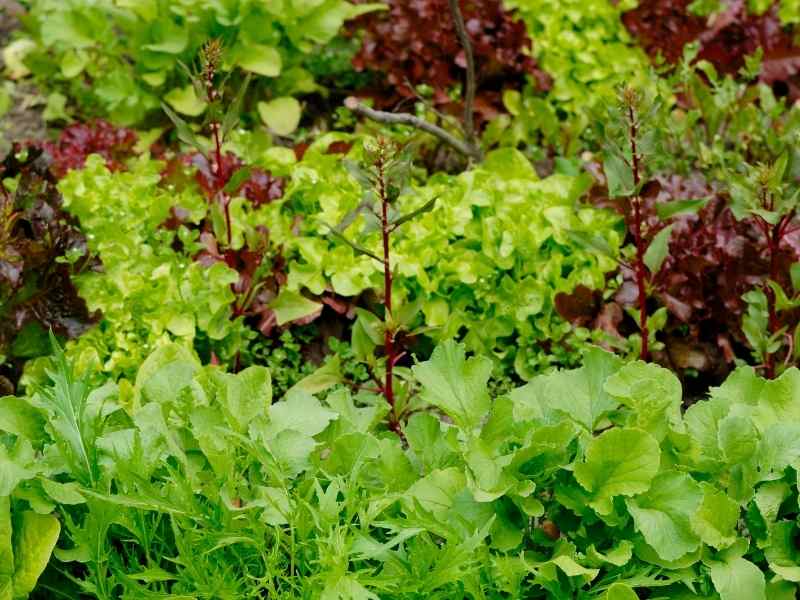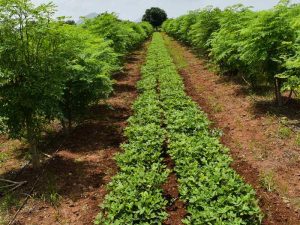Lettuce is a fresh leafy green that’s a popular addition to summer salads or sandwiches worldwide, and if you’re into gardening, it’s more than likely you will grow a variant of this plant in your garden. But what do you do if it begins to taste bitter?

Lettuce can become bitter from three major causes: nutritional deficiency, environmental causes, and a disease known as aster yellows. There are prevention steps for each of these conditions, and it all starts with observation and taking action.
In this article, we are going to discuss all things lettuce related. So keep reading. We have everything you need to know about bitter lettuce and how to solve it.
Lettuce is Great Until it Turns Bitter.
Lettuce is a popular leafy green added to salads and sandwiches, giving them a crisp fresh taste. It has become a popular lush green for home gardens as it almost always tastes fresher than what you can buy from the supermarkets. There are many varieties of lettuce, ranging in color from green to red.
As with all things, though, lettuce needs some tender love to keep it at its freshest, as there is nothing worse than going into the garden and picking a head that you watched blossom, only for it to taste bitter.
Once it turns bitter, it will never again be the delicious salad ingredient we’ve all come to love, and the only place it will go is in the compost pile. But even seemingly fresh-looking lettuce tastes bitter after I’ve plucked it from the garden, so what are the main problems we’re dealing with?
There are three main reasons why your lettuce will start to taste bitter. Environmental conditions which include too much heat or insufficient water, nutritional deficiency, and, finally, aster yellows. Let’s not let our hard work growing lettuce go to waste. Following this article’s simple steps, we can all have fresh and crisp lettuce.
Problem #1 – Not Enough Nutrients
Lettuce is a plant that loves to grow quickly, so if you cannot supply it with a sufficient amount of quality plant nutrition, it’s sure to bolt and turn bitter long before your harvesting season has finished.
If lettuce doesn’t get enough nutrients, such as nitrogen, it can cause this salad favorite’s growth to be stunned. Not enough nitrogen will result in small leaves that cannot reach their full tender capacity due to a lack of nutrition.
As lettuce is a plant that enjoys cooler weather, it tends to require a heavy amount of food to promote its optimal growth. So when growing lettuce, make sure your soil has plenty of nutrients such as nitrogen to give it a healthy start to the growing season.
Not Enough Nutrition: Prevention
Before transplanting your lettuce plants or direct sowing your seeds into a space in the garden or a larger pot, be sure to work in a complete organic fertilizer with equal nitrogen, phosphorus, and potassium or a rich homemade compost. This will give your leafy greens all the food they need to grow.
You can also plant your lettuce with companions such as legumes or beans, as they fix the nitrogen level in the soil. Alternatively, you can rotate crops so that your lettuce follows beans in seasons.
Check out this article on Plants That Increase Soil Fertility
Problem #2 – Environmental Conditions
The second reason why people end up with bitter lettuce is the environmental conditions that the lettuce is subject to. This can range from your lettuce not getting enough water to hot weather causing your lettuce to bolt.
One of the main reasons your lettuce will become bitter is bolting. This is when a plant puts its energy into producing stalks and buds that open and bloom, making seeds if they’re pollinated. This reproductive cycle can cause the plant to form bitter compounds in leaves and stems.
Your lettuce will bolt faster in response to environmental conditions such as scorching weather or lack of rain and watering. As lettuce thrives in cool weather, too much heat or too little water feels life-threatening to the plant, so it begins the reproduction process.
Water stress also leads to lettuce tasting bitter. The lack of moisture is often associated with the hot weather that instigates bloating, especially in homegrown romaine, buttercrunch, and loose leaf lettuce.

Environmental Conditions: Prevention
So what can we do against the environmental conditions we may come up against when growing lettuce that is both fresh and tasty?
This can be done through simple planning of your season. Before sowing your lettuce, make sure you make a note of the number of days to maturity and plan to harvest before the highest heat of the year hits your area.
Simple tips to avoid the bolting caused by too much heat are: plant your lettuce in partial shade, jump on the season by starting your plants indoors and place mulch around your plants after a few inches tall.
You want to start with a proper garden preparation to get past the moisture stress. Make sure you plant your lettuce in loamy soil infused with plenty of organic material, as this will help it retain an excellent moisture level and drain well.
If you’re going to use a pot, use a rich potting mix that drains well. Ensure the container is coated to prevent evaporation and give it plenty of holes in the bottom for optimal drainage.
It should go without saying, but make sure your lettuce is getting enough water. It has shallow roots, so plants need consistent watering. Check twice a week and water your plant if the soil is dry down to 1 inch. If in a garden bed, check more frequently.
Problem #3. Aster Yellows
The third major problem behind your lettuce tasting bitter is a disease caused by a microscopic phytoplasma known as Aster Yellows. This disease acts like a bacteria and is transferred by insects such as leafhoppers.
You will know when you have yellow asters, as your plants will have pink or tan spots on the leaves and twisted leaves at the plant’s core. Aster Yellow will make your lettuce just about as bitter and horrible as it can get
Aster Yellows: Prevention
Aster yellows affect more than three hundred plants, including crops like wheat and barley. Aster yellows can spread rapidly and get out of control without effective management. If your lettuce plants end up suffering from aster yellows, you’re in trouble as there is no cure, so the best thing to do is prepare to prevent this disease.
Some simple steps can help prevent this disease from tearing through your garden. This mainly includes planting lettuce varieties resistant to aster yellows, the removal of diseased plants from your garden, and sometimes eliminating the insects that carry the disease.

If you are well managed and plan for the season, you can easily prevent the spread of aster yellows throughout your plants. One idea is to take some time every few days and look for clear indicators of the disease, and if identified, take immediate action to remove the infected plants.
Conclusion
So if you want to enjoy delicious lettuce from your garden and grow it in abundance, within this article, you have learned the basic steps to avoid bitter-tasting lettuce that no one wants inside their salad. You’re now ready to get out into the garden and combat all conditions that will keep you from the freshest tasting lettuce.



